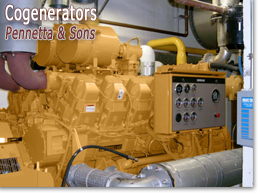|
Pennetta & Sons - Cogenerators
We provide expert installation, service and repair of all co-generation technology.
Cogeneration Technology
A typical cogeneration system consists of an engine, steam turbine, or
combustion turbine that drives an electrical generator. A waste heat exchanger
recovers waste heat from the engine and/or exhaust gas to produce hot water or
steam. Cogeneration produces a given amount of electric power and process heat
with 10% to 30% less fuel than it takes to produce the electricity and process
heat separately.
Cogeneration Applications
 Cogeneration systems have been designed and built for many different applications.
Large-scale systems can be built on-site at a plant, or off-site. Off-site plants
need to be close enough to a steam customer (or municipal steam loop) to cover the
cost of a steam pipeline. Industrial or commercial facility owners can operate the
plants, or a utility or a non-utility generator (NUG) may own and operate them.
Manufacturers use 90% of all cogeneration systems. Some industries and waste
incinerator operators who own their own equipment realize sizable profits with
cogeneration. Cogeneration systems have been designed and built for many different applications.
Large-scale systems can be built on-site at a plant, or off-site. Off-site plants
need to be close enough to a steam customer (or municipal steam loop) to cover the
cost of a steam pipeline. Industrial or commercial facility owners can operate the
plants, or a utility or a non-utility generator (NUG) may own and operate them.
Manufacturers use 90% of all cogeneration systems. Some industries and waste
incinerator operators who own their own equipment realize sizable profits with
cogeneration.
Another large-scale application of cogeneration is for district heating. Many
colleges and cities, which have extensive district heating and cooling systems,
have cogeneration facilities. The University of Florida has a 42 Megawatt (MW)
gas turbine cogeneration plant, built in partnership with the Florida Power
Corporation. Information on the system and other technical references are available
on the World Wide Web (see address below).
Some large cogeneration facilities were built primarily to produce power. They
produce only enough steam to meet the requirements for qualified facilities under
PURPA. If no steam host is nearby, one can be built. For example, there are large
(80 MW) plants operating under PURPA that have large greenhouses as "steam hosts."
 The greenhouses operate without losing money only because their steam heat is
virtually free of charge. These types of plants are candidates to become EWGs in
the new regulatory environment. The greenhouses operate without losing money only because their steam heat is
virtually free of charge. These types of plants are candidates to become EWGs in
the new regulatory environment.
Many utilities have formed subsidiaries to own and operate cogeneration plants.
These subsidiaries are successful due to the operation and maintenance experience
that the utilities bring to them. They also usually have a long-term sales contract
lined up before the plant is built. One example is a 300 MW plant that is owned and
operated by a subsidiary co-owned by a utility and an oil company. The utility feeds
the power directly into its grid. The oil company uses the steam to increase
production from its nearby oil wells.
Cogeneration systems are also available to small-scale users of electricity. Small-scale
packaged or "modular" systems are being manufactured for commercial and light industrial
applications. Modular cogeneration systems are compact, and can be manufactured economically.
These systems, ranging in size from 20 kilowatts (kW) to 650 kW produce electricity and
hot water from engine waste heat. It is usually best to size the systems to meet the hot
water needs of a building. Thus, the best applications are for buildings such as hospitals
or restaurants that have a year-round need for hot water or steam. They can be operated
continuously or only during peak load hours to reduce peak demand charges, although
continuous operation usually has the quickest payback period.

For customer service, use our contact form or email
customerservice@pennetta.com
TELEPHONE: (201) 420-1693
|